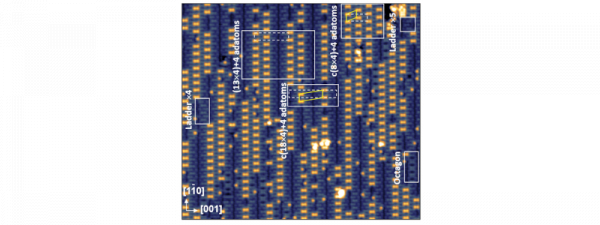The article is the result of a collaboration between French researchers from CNRS (Institut des NanoSciences of Paris and CINaM of Marseille), synchrotron facility SOLEIL and Italian researchers from CNR-ISM.
The two-dimensional structures of silicon on Ag (110) were studied by grazing incidence X-ray diffraction and scanning tunneling microscopy. The thermodynamic stability of different structural models has been explored by ab initio theoretical calculations The combination of these experimental and theoretical techniques has allowed us to demonstrate that, by adding silicon atoms to the pentameric structures called nanoribbons that are formed by depositing silicon on Ag (110), these one-dimensional structures evolve into a two-dimensional silicene single layer. Finally, a further slight increase of deposited silicon gives rise to the formation of dumbbell silicene, in which the presence of silicon adatoms regularly distributed on the silicene layer results in a further stabilization of the two-dimensional silicon structure.
Monday, 20 September 2021 10:46
Demonstration of the Existence of Dumbbell Silicene: A Stable Two- Dimensional Allotrope of Silicon
 STM image of the Ag(110) substrate covered by the silicene layer. The bright features are the silicon adatoms in dumbbell configuration
STM image of the Ag(110) substrate covered by the silicene layer. The bright features are the silicon adatoms in dumbbell configuration
In this paper published in The Journal of Physical Chemistry C it is demonstrated that, by extending the amount of deposited silicon beyond the limit required for the well-known formation of silicon nanoribbons, novel two-dimensional silicon structures are obtained: silicene and dumbbell silicene. The possibility of synthesizing dumbbell silicene, already predicted by theoretical calculations, opens up interesting perspectives for the exploration of the functionalization and predicted topological properties of this new 2D silicon allotrope.
#Silicene #2D_materials #Grazing_incidence #Xray_diffraction #Density_functional_theory #Scanning_Tunneling_Microscopy #Synchrotron_radiation
Published in
Publications

 English (UK)
English (UK)  Italiano (Italia)
Italiano (Italia)